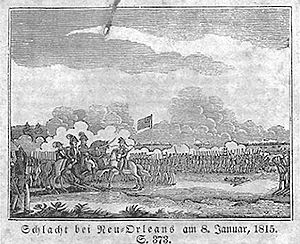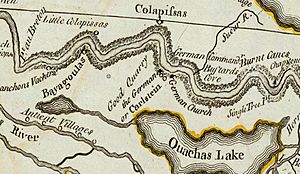German Coast facts for kids
The German Coast was a special area in early Louisiana. It was located along the west bank of the Mississippi River, just north of New Orleans. This region got its name because many German immigrants settled there. Today, this area includes parts of St. Charles, St. John the Baptist, and St. James parishes. The settlers built large farms, known as plantations, where enslaved people were forced to work.
The Whitney Plantation, a museum about slavery, opened in 2014 on the German Coast. It helps people learn about the history of slavery.
Contents
Early Settlements
In 1720, about 4,000 Germans from the Rhine valley were asked to move to Louisiana. However, the journey was very difficult. Many people died along the way due to harsh conditions. Only a few hundred actually made it to their new home. By March 1722, about 330 settlers had arrived.
The German villages in this area were collectively known as Karlstein. This name honored Charles Frederick d'Arensbourg, who was a respected leader for the German settlers for over 55 years. By 1723, the area had many homes. These were part of settlements like Hoffen, Augsburg, and Mariental.
The Company of the Indies brought these German immigrants to the area in 1721. Charles Frederick d'Arensbourg led them. When the company closed in 1731, the German settlers became independent landowners.
Even with floods, hurricanes, and the challenges of frontier life, the German pioneers succeeded. Their farms grew enough food for themselves and for the people in New Orleans. Some historians believe these German farmers were very important for New Orleans to survive in its early days.
Between 1769 and 1777, Governor Luis de Unzaga helped more European families settle in Louisiana. He gave them land and farming tools. Unzaga also supported different languages. He even created the world's first bilingual public school system in New Orleans. This allowed people to keep speaking languages like English and German.
German Coast Culture
Most of the German Coast settlers came from the Rhineland region of Germany. Others came from German-speaking parts of Switzerland, Alsace-Lorraine in France, and some from Belgium.
Soon after arriving, the German immigrants began speaking French. They also married early French settlers. Over time, they married descendants of these French settlers and also the Acadians. Acadians are the people who later became known as "Cajuns."
Many common Cajun family names actually have German roots. For example, names like Schexnayder, LaBranche, Folse, Zeringue, Hymel, and Trosclair come from German names.
Military Actions

In 1768, German colonists joined with Acadians from the Cabannocé area. They marched on New Orleans to overthrow the new Spanish governor, Antonio de Ulloa. This event is known as the Louisiana Rebellion of 1768.
A few years later, the German and Acadian settlers worked together again. Under Spanish Governor Bernardo de Gálvez, they fought against the British. This happened during the American Revolutionary War.
1811 Slave Uprising
The German Coast was the location of a very large slave revolt in US history. This was the 1811 German Coast uprising in 1811. It happened after the United States had taken control of the Louisiana Territory.
The leaders of this rebellion were enslaved men named Quamana and Harry, and a free man of color named Charles Deslondes. They gathered an estimated 500 enslaved people from plantations along the River Road. They then marched toward New Orleans. The rebels killed two white men but did not have many weapons.
Local armed groups were called to stop the uprising. They killed nearly half of the 95 enslaved people who died during the rebellion. The remaining enslaved people were executed after trials were held in the parishes, including Orleans Parish.
World War I Impact
During World War I, there was strong anti-German feeling. Because of this, the Louisiana state government passed a law called Act 114. This law made it illegal to express German culture or heritage in the state. It especially banned the use of the German language, both in print and spoken. While the German language had already become less common among the descendants of the original German Coast settlers, this law affected descendants of more recent German immigrants.
See also
In Spanish: Costa Alemana para niños


